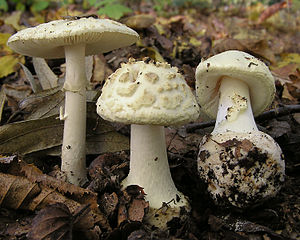Yellow death cap mushroom
| Yellow death cap mushroom | ||||||||||||
|---|---|---|---|---|---|---|---|---|---|---|---|---|

Yellow death cap mushroom ( Amanita citrina ) |
||||||||||||
| Systematics | ||||||||||||
|
||||||||||||
| Scientific name | ||||||||||||
| Amanita citrina | ||||||||||||
| (Schaeff.) Pers. |
The Yellow amanita ( Amanita citrina , Syn. : A. mappa ), also known as Canary Knollenblätterpilz , Yellowish Knollenblätterpilz or Yellow Amanita known is a species of fungus from the family of Wulstlingsverwandten .
features
Macroscopic features
The yellow cap mushroom has a 3–10 cm wide hat of light lemon-yellow to whitish color, on which there are often lumpy, white remains of the shell. The lamellas are white and not attached to the stem . The stem is 5–15 cm long. It is thin-fleshed, white-yellowish and has an even ring and a clearly bulbous base, which is in a pot-like, firmly attached and angular sheath separated from the rest of the stem. The meat is white and smells musty like potato sprouts.
The alba variety lacks the yellow pigment, so the fruiting bodies have an ivory-colored hat and stem. Those specimens can also grow between normal colored ones.
Microscopic features
The smooth, round, and amyloid spores measure 8–10 × 7–8 µm.
Species delimitation
The tuberous base of the stem of the green , cone-hat and spring cap mushroom, which are highly toxic due to the content of amatoxins and phallotoxins , are stuck in lobed sheaths.
ecology
The yellow cap mushroom is a mycorrhizal fungus that can be associated with various coniferous and deciduous trees. The main tree partner in Central Europe is the common spruce , followed at a distance by the common beech , as well as pine, oak species, birch and others. The yellow capillary mushroom occurs in various acidic forest types, it prefers medium-sized, base and nutrient-poor soils that should be moderately fresh to moderately moist. In the 19th century , the species profited from the forest spread of the spruce and for a time even from acid rain , which caused greater damage to competing fungus species. Later, the yellow cap mushroom suffered from increasing damage to the spruce, its preferred mycorrhizal partner. The fruiting bodies appear in Central Europe mainly from August to November, leading as early as June.
distribution
The yellow capillary mushroom occurs in Australia and South Africa, in the Holarctic its range includes the Mediterranean and temperate latitudes, it is found in the Caucasus, Korea and Japan, the USA, Canada and the Canary Islands. In Europe it occurs from the Mediterranean area to the Hebrides and southern Scandinavia, eastwards to Belarus and Estonia. Its northern distribution limit corresponds to that of the oaks.
meaning
The yellow cap mushroom is not an edible mushroom. Unlike the green cap mushroom , with which it can easily be confused, the yellow cap mushroom is only poisonous in its raw state, since the bufotenin loses its effect when heated. In this respect, the mushroom is even edible, but due to the high risk of confusion and the bad taste, it should not be collected for the kitchen.
swell
- Distribution of the daffodil yellow amanita in Germany. In: Mushroom Mapping 2000 Online . Edited by Axel Schilling, Peter Dobbitsch. German Society for Mycology (DGfM), 2004, accessed on August 1, 2012 .
- German Josef Krieglsteiner (Ed.), Andreas Gminder : Die Großpilze Baden-Württemberg . Volume 4: Mushrooms. Blattpilze II. Ulmer, Stuttgart 2003, ISBN 3-8001-3281-8 .
